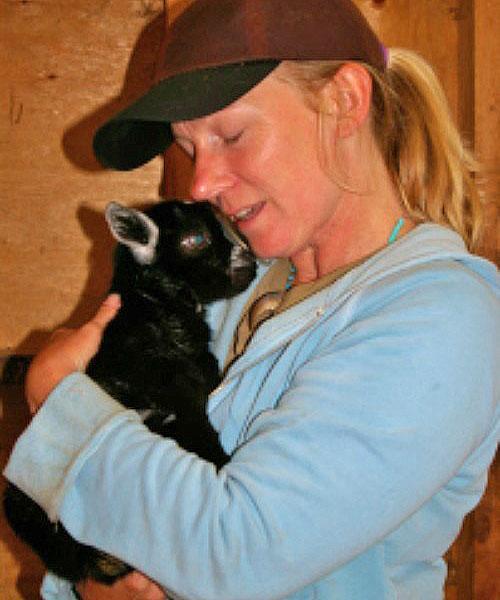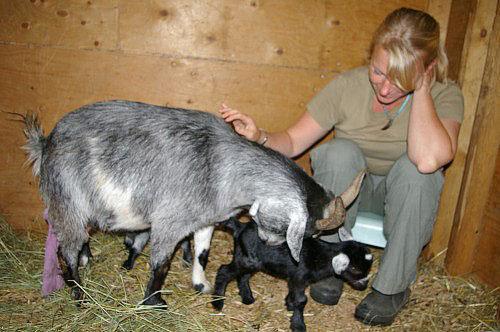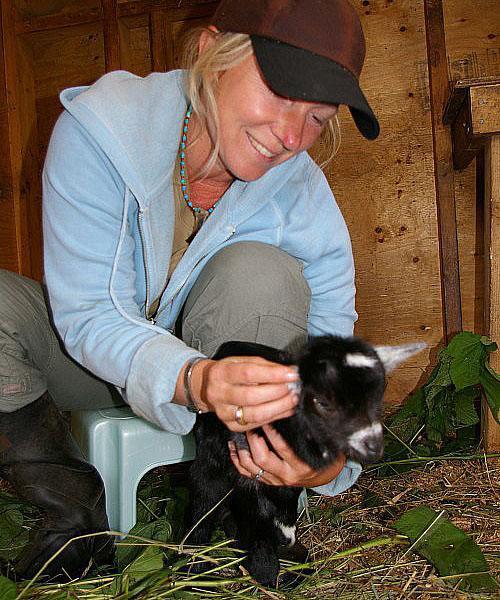Imprint training with goats
 Many years ago I was fortunate enough to attend a seminar that Dr. Robert M. Miller taught in Palmerston North, New Zealand. He talked about his technique of imprint training with newborn foals and mules. Through his many years of experience as an equestrian veterinarian, Miller discovered that there was a significant difference between the behavior of adult horses he met and animals that he either attended or visited and treated shortly thereafter. He noticed that the horses with which he was in contact from birth perceived him as part of the herd, and not as a stranger. Often, they even galloped across the field to greet Miller, barely spotting him on the horizon.
Many years ago I was fortunate enough to attend a seminar that Dr. Robert M. Miller taught in Palmerston North, New Zealand. He talked about his technique of imprint training with newborn foals and mules. Through his many years of experience as an equestrian veterinarian, Miller discovered that there was a significant difference between the behavior of adult horses he met and animals that he either attended or visited and treated shortly thereafter. He noticed that the horses with which he was in contact from birth perceived him as part of the herd, and not as a stranger. Often, they even galloped across the field to greet Miller, barely spotting him on the horizon.
After pondering for a long time why the attitude of some horses towards him is so different (as if he is a member of the family), Dr. Miller managed to piece the puzzle together and established the factor that unites all animals - a person was present at the birth of each of them. Miller began planning further experiments with foals based on this discovery. He began to carry out certain manipulations with newborn animals, as if he were examining them in the role of a veterinarian: he touched the ears, nasal passage and anus with his fingers, thereby imitating the process of measuring temperature.
The obvious success of such experiments allowed him to create his own imprint technique, which Miller began to use in his breeding program. He showed us videos in which he worked with animals, familiar with him from birth. It was impossible not to notice a clear connection between them. If you are interested in horses (or treat other animals as well), I would recommend that you purchase the book Imprint Training of Newborn Foals published by Western Rider (1991). Although the book is about horses, I have used many of the techniques described with my dogs, and now I am applying them to my goats. Indeed, the time spent with me in the first 24 hours after birth was imprinted in the animal's brain for life. The goat happily greeted me when I entered the barn, and completely relaxed in my arms, allowing me to do whatever I wanted with it.
Postpartum procedure

Wiping dry
 When the kid has been partially licked by the mother (at least the head and neck), you can start drying it with a towel. Then start touching and stroking these areas with your hands, allowing the animal to remember your scent. Do not chase the goat away if it wants to be around the cub. In the process, the baby will kick and get nervous. You must be affectionate and persistent.
When the kid has been partially licked by the mother (at least the head and neck), you can start drying it with a towel. Then start touching and stroking these areas with your hands, allowing the animal to remember your scent. Do not chase the goat away if it wants to be around the cub. In the process, the baby will kick and get nervous. You must be affectionate and persistent.
Stimulation through addiction
 It is impossible to overdo it with the amount of tactile touches, on the contrary, they may not be enough.If you allow the animal to avoid contact by dodging your hands, this behavior will be deposited in its brain. Continue touching the baby until he is completely relaxed and stops resisting. The idea is for the animal to first feel the discomfort, and then get rid of this feeling in the gentle hands of a person. This early interaction with the young will bear fruit when it is fully grown. Dr Miller calls the relaxed acceptance of human touch "parenting," although many would call it "submission."
It is impossible to overdo it with the amount of tactile touches, on the contrary, they may not be enough.If you allow the animal to avoid contact by dodging your hands, this behavior will be deposited in its brain. Continue touching the baby until he is completely relaxed and stops resisting. The idea is for the animal to first feel the discomfort, and then get rid of this feeling in the gentle hands of a person. This early interaction with the young will bear fruit when it is fully grown. Dr Miller calls the relaxed acceptance of human touch "parenting," although many would call it "submission."
This is especially important in horse rearing, as they are much larger than goats in adulthood. Your relationship will directly depend on their behavior.
Desensitization
 Don't be in a hurry! Rub your head, nose, ears, belly, and under the tail. Massage all parts of the body thoroughly until the animal relaxes, allowing the impact. Miller notes that 30 to 100 repetitions are required for foals, but I have found that things are much easier with kids. With the proper perseverance, it took me about 10-20 reps, the ears turned out to be the most problematic area for getting used to. Now I can sit, absentmindedly tugging at the ears of a goat, which gladly puts them up for caress. She may even fall asleep in her arms and does not react in any way if I touch her tail or stroke her under it. (goats hate being touched by the tail!)
Don't be in a hurry! Rub your head, nose, ears, belly, and under the tail. Massage all parts of the body thoroughly until the animal relaxes, allowing the impact. Miller notes that 30 to 100 repetitions are required for foals, but I have found that things are much easier with kids. With the proper perseverance, it took me about 10-20 reps, the ears turned out to be the most problematic area for getting used to. Now I can sit, absentmindedly tugging at the ears of a goat, which gladly puts them up for caress. She may even fall asleep in her arms and does not react in any way if I touch her tail or stroke her under it. (goats hate being touched by the tail!)
Training objectives
 The key task of imprint training is to simplify interaction with an adult animal. Imagine a situation in which you need to give him an injection, or the veterinarian has to unclog the ear canal and insert a thermometer into the anus. In order for the animal to become a “veterinarian's dream”, it is necessary to work with it first. As soon as touching becomes familiar to him, begin to insert your fingers into the mouth, nose, ear canal and anus. Do not under any circumstances start the procedure from the anus. You should start with the head and gradually move down.
The key task of imprint training is to simplify interaction with an adult animal. Imagine a situation in which you need to give him an injection, or the veterinarian has to unclog the ear canal and insert a thermometer into the anus. In order for the animal to become a “veterinarian's dream”, it is necessary to work with it first. As soon as touching becomes familiar to him, begin to insert your fingers into the mouth, nose, ear canal and anus. Do not under any circumstances start the procedure from the anus. You should start with the head and gradually move down.
Limbs
Now you can work with less sensitive areas. Make sure your feet, legs, groin, and belly are not overlooked. As mentioned earlier, massage and stroke all areas until the animal is completely relaxed. Goats 'hooves need to be trimmed regularly (as opposed to horses' hooves), so it is imperative that the animal gets used to manipulating the legs.
Let the mother be with the baby while you work with it. Treat the indicated areas, but let the goat lick and feed the baby between repetitions. This will help both animals calm down faster. This process should not be forced, it can take several hours or several days.
The next day
 They are only 26 hours old, and the kids already know me and treat their hands with ease and confidence. To consolidate the effect, I will continue to touch daily for the next few weeks as the cubs grow.
They are only 26 hours old, and the kids already know me and treat their hands with ease and confidence. To consolidate the effect, I will continue to touch daily for the next few weeks as the cubs grow.
Miller's work
His work with horses is much more extensive than what I have described above, and for good reason. Raising horses is an art in itself, so it takes much more effort than I spend on goats. Please study the book and his life's work if you are interested in the imprint training technique, and also if you would like to try it with your horses or other animals. I do not pretend to be an expert in this area, I just adapted some of Miller's techniques for my work on the farm and the animals with which I interact. With Dr. Miller's course, your foal will transform from a foolish calf into a fully trained adult horse!